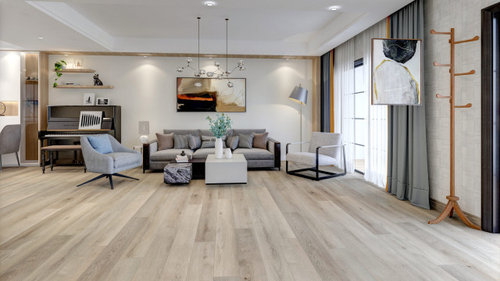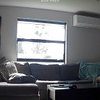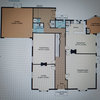What is hybrid flooring? (get the facts not the hype)
There is a lot of mis-information in Australia about Hybrid Flooring...here are the FACTS.

(Pictured above is the 9mm Lumina Longboard GEN 2 Hybrid that uses digital printing. Colour Twilight)
Hybrid flooring launched in Australia in 2017 and was the result of efforts from a select group of professionals from three companies, being two importers and a retail group. Two of the main people involved in creating this category are the Co-Founders and Directors of our parent company so we are lucky to be able to provide this advice to you straight from the pioneers of this category in Australia rather than the pages and pages of mis-information and mis-truths that are plastered all over the internet and rolling from the tongues of slick salespeople Australia wide.
Hybrid flooring is the category name used in Australia to describe an innovative range of flooring products that can trace it's history back to the 1st Generation of Hybrid flooring launched by Piet Dossche of USFloors in 2013.
In 2013, it was discovered in a factory in Zhejiang province in China that a foamed Wood Plastic Composite (WPC) core could be extruded and then bonded to a Luxury Vinyl Plank (LVT) surface to create a new floating waterproof flooring system superior to regular vinyl planks (as it could be installed by almost anyone rather than relying on vinyl installers) and much better with moisture than traditional laminate floors.
The term Hybrid was used in Australia to market the category as it most accurately portrays its new and inventive nature. It is a category, not a particular product. Hybrid is a floor category that describes floors that are not pure laminates, pure timbers or pure vinyls, but are combinations or iterations of developing technological advances. It is an ideal category name for new and emerging technologies as hybrid literally means "of mixed character; composed of different elements".
In 2016 a new format of Hybrid flooring, what we refer to as 2nd Generation Hybrid was invented that refined the process by making it a one-step process to make the Hybrid flooring (rather than the 1st Generation where two separate products being a core and a surface were made then combined).
The way this was done was to remove the wood flour content and the aeration of the core and rather extrude a Stone Plastic Composite (SPC) core made from limestone in the form of calcium carbonate and PVC and at the same time apply the decor and surface wear layer all on the one machine, making it more cost effective and faster to produce, meaning it was also less at the retail level for customers than the more labour intensive WPC 1st Generation option.

(Side profile of a 2nd Generation Hybrid Floor)
The solid nature of the SPC meant it was originally marketed towards commercial settings in markets like North America whereas the WPC alternative was focused on the residential market. Australia largely skipped the 1st Generation Hybrid floors as the Australian market had experienced terrible outcomes with unstable click vinyl planks in previous years and so Australia only embraced Hybrid flooring in the back half of 2017 once the 2nd Generation products were developed and the brand new category created and launched.
In or around 2018, a governing body emerged that the larger manufacturers signed up to and the naming conventions streamlined so that two main streams of Hybrid flooring were recognised, first being Expanded Polymer Core (EPC) which replaced WPC (as wood flour was no longer being used) and the "expanded" term accurately referred to the aeration of the core.
The second was Solid Polymer Core (SPC) which clarified the often confusing terminology of Stone Plastic Composite, Stone Polymer Core and all the other iterations the market was seeing. "Solid" meaning it is not aerated and is solid.
Both EPC and SPC are 2nd Generation Hybrid floors. There are various iterations of these and some brands claim to be "next generation" but look into it to see if they are or if it is a marketing spin.
So, in general, 2nd Generation Hybrid floors are based around the concept of delivering a veneer of PVC protecting the picture of timber or stone bonded to a waterproof core that can be floated rather than stuck down.
Are most of them good?....yes they are, but the category also has its limitations and is "oversold" as a miracle floor by those who don't know better (sometimes deliberately misleading, but more often just through ignorance) and pumped pretty hard on forums as it is relatively new and shiny.
As the factories knew the products had it's limitations and naturally are always looking for ways to be more competitive, since 2017 factories have searched for ways to improve their Hybrid floors and experimented with various formats that included Mineral Fibre Board (MFB) and also attempted adding a veneer of real timber to an SPC core, known widely as VSPC.
Another good example of these types of developments are the magnesium core boards referred to as an MGO product.
Whilst factories in China were racing to develop new versions of Hybrid, KronoSwiss, one of the worlds largest producers of wood based building materials including laminate flooring, launched Corepel in the US market and was the first to properly launch what we refer to as a 3rd Generation (GEN 3) Hybrid floor.
In our opinion, Corepel was the first commercially successful PVC FREE Hybrid floor made using majority wood based materials and still being waterproof, yet added extreme scratch resistance and at the same time fixed the issues around hot and cold (as it isn't made from plastic).
It's core is referred to by KronoSwiss as a Durable Eco Composite (DEC) and it combines the waterproof factors of GEN 2 hybrid floors with the proven surface technology of higher end laminate floors that KronoSwiss are renowned for.
Corepel is not currently available in Australia (at the time of writing this article).
In 2023, a new 3rd Generation Durable Waterproof Core (DWC) was launched in Australia (and available at The Flooring Centre) to compliment the vast range of 2nd Generation Hybrid flooring options.
This new GEN 3 DWC is a true 3rd generation PVC FREE Hybrid floor that ensures the wood fibres are wrapped in a wax encapsulation to protect them from moisture (yes, it is also waterproof) whilst allowing the use of highly scratch resistant laminate flooring technology to be used on the surface.
GEN 3 Hybrid flooring is a significant leap forward for manufacturers and customers alike and is better for the environment as it uses no PVC in the core, surface or attached underlay (it's also VOC E-ZERO rated for total peace of mind).
The HYPE around 2nd Generation Hybrid is a little out of control and the claims made by many retailers, both in stores and online, about the durability (the surface is only plastic and yes it DOES scratch) and suitability for many situations are inaccurate to say the least.
In 2024, we are seeing global interest (at the big international trade shows such as Domotex in Hanover and Surfaces in Las Vegas) centre on PVC FREE flooring and most major manufacturers are starting to pour time and money into developing what we refer to as GEN 3 Hybrid floors that are more renewable, more durable and more attuned to the demands that families place on them.
Examples of 2nd & 3rd Generation Hybrid Flooring
Do you own research and make the right decision the first time & of course feel free to ask any questions here and we can assist you.


Related Discussions
Needing ideas for blank wall
Q
Kitchen redesign ideas needed
Q
Do you ask your guests to remove their shoes?
Q
Kitchen symmetry needed
Q